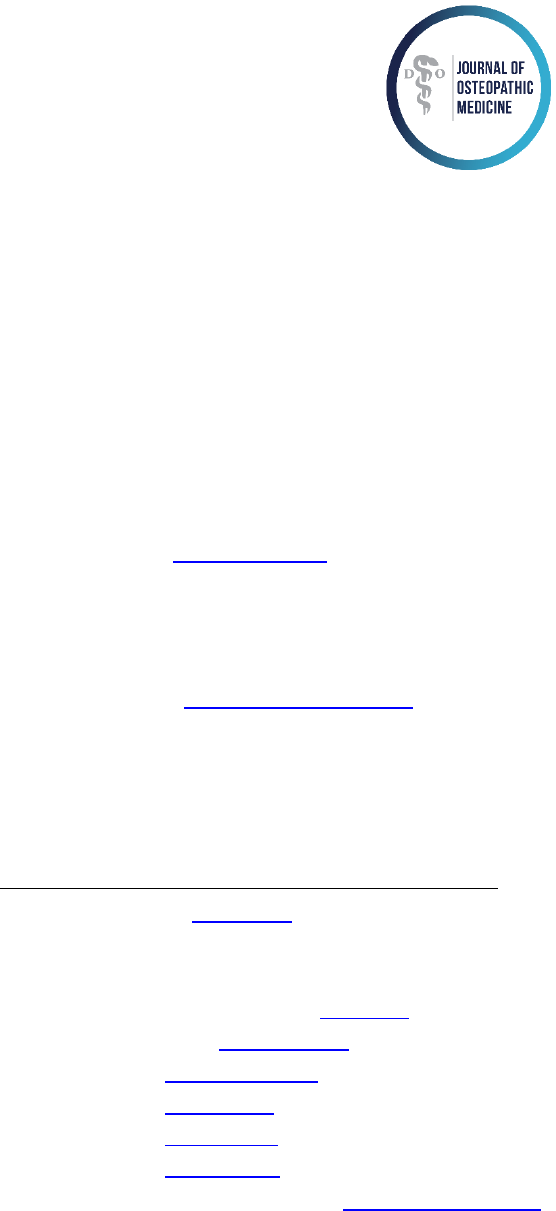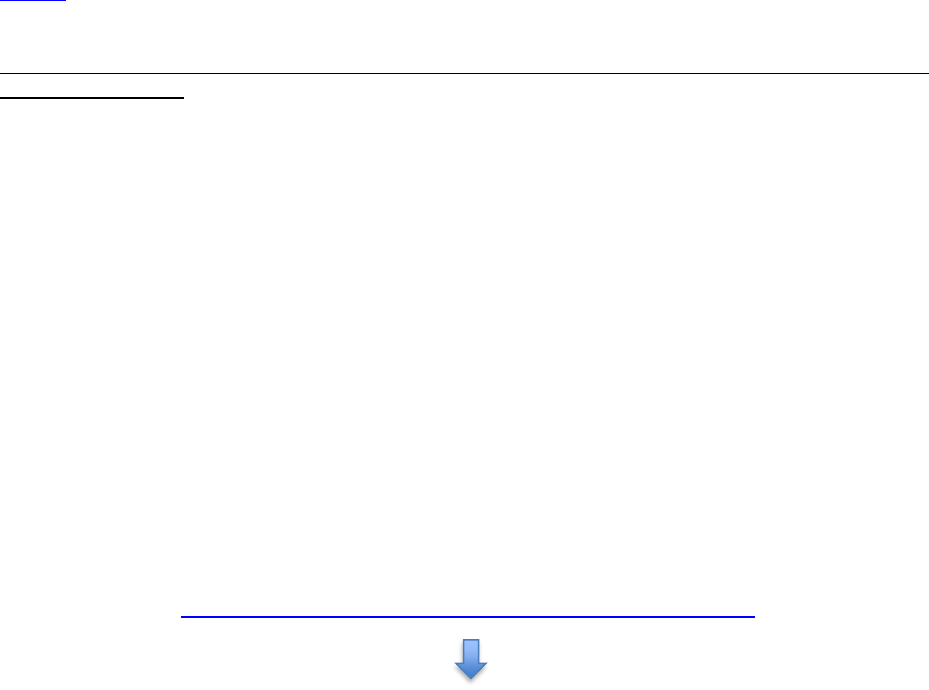
Case Report Template
We offer this template to assist all authors of Case Reports being submitted to the Journal of
Osteopathic Medicine in preparing their work for efficient peer review.
Please note that JOM now accepts a very limited number of Case Reports, focusing only on
those that represent truly novel or unusual contributions to the literature. All Case Reports are
evaluated first by our Editors based on uniqueness of subject matter, relevance to our
readership, and previous publication of similar studies. Case reports must describe clinical
presentations that have strong relevance to osteopathic medicine. These manuscripts must also
include results of osteopathic structural examinations and a relevant literature review. Authors
should follow the CARE guidelines.
If any of the information outlined in this template is missing from your submission, your
manuscript may be returned to you for resolution prior to peer review.
Please refer to our Instructions for Authors for more information about various technical criteria
and a more general overview of each article type.
Please also take great care to ensure that your research, data analysis, and language conform
adequately to our requirements for racial and ethnic categorization of patients.
As a reminder, every Case Report must contain:
• A separate title page with full disclosure information, as outlined below
• A blinded main manuscript file without identifying information for the authors
and/or their institutions, to include:
o An unstructured Abstract
o A brief Introduction
o A Report of Case section
o A Discussion section
o A Conclusion section
o A References section in strict AMA format with 50 or fewer references
• Any relevant high-quality Figures and Videos as separate files
TITLE PAGE
Article Domain Category [CHOOSE ONE]: Behavioral Health, Cardiopulmonary Medicine, General, Innovations,
Medical Education, Musculoskeletal Medicine, Neuromusculoskeletal Medicine/ Osteopathic Manipulative
Treatment (OMT), Obstetrics/Gynecology, Pediatrics, Public Health and Primary Care
Article Type: Case Report
# Tables/# Figures/# Appendices
Article Title
• Each word capitalized, except prepositions
(Running Title)
• In parentheses and italicized under the main title
• A shortened version of your title that would appear in the header on a published manuscript
• No more than 50 words
o eg, (Running Title: ….)
Author Bylines
• Periods after middle initials, comma before degrees, each author separated by semicolon
• No Fellowship credentials are permitted.
• Authors should be listed with the credentials that were valid at the time the study was completed, even if
they have graduated.
o eg, Jane A. Johnson, MA; Janet B. Jones, DO
Author Affiliations
• Each author should be listed with her/his affiliations on a separate line.
• The listing should include division, department, institution, city, and state where applicable.
o eg, Dr. Janet B. Jones, DO, A.T. Still Research Institute and the Department of Osteopathic Manipulative
Medicine at the A.T. Still University Kirksville College of Osteopathic Medicine in Missouri.
• Please add the ORCID ID for each author to her/his affiliation line and provide the Twitter handle of any
authors/institutions who would like to be tagged in social media efforts to promote your work.
Financial Disclosures
• List “None reported.” or detail those of each individual author.
• Payment alone is not a criterion for disclosure, nor is relevance to the study subject. All affiliations outside
of regular employment disclosed in the affiliations section listed above must be disclosed here. We follow
AMA guidelines for this category, which state:
“Authors are expected to provide detailed information about all relevant financial interests, activities,
relationships, and affiliations (other than those affiliations listed in the title page of the manuscript)
including, but not limited to, employment, affiliation, funding and grants received or pending, consultancies,
honoraria or payment, speakers' bureaus, stock ownership or options, expert testimony, royalties, donation
of medical equipment, or patents planned, pending, or issued. Following the guidelines of the ICMJE, the
definitions and terms of such disclosures include: (1) Any potential conflicts of interest ‘involving the work
under consideration for publication’ (during the time involving the work, from initial conception and
planning to present); (2) Any ‘relevant financial activities outside the submitted work’ (over the 3 years prior
to submission); and (3) Any ‘other relationships or activities that readers could perceive to have influenced,
or that give the appearance of potentially influencing’ what is written in the submitted work (based on all
relationships that were present during the 3 years prior to submission).”
Support
• List “None reported.” or detail those of each individual author.
• Support includes both grants and provision of any material used in the study.

• You must provide qualitative (but not quantitative or accounting) details about how your funding was
distributed for the study. This can include things like faculty protected time or patient compensation.
o Of note, patient compensation must also be disclosed clearly in your Methods section.
o We follow AMA guidelines for this category, which state:
“All financial and material support for the research and the work should be clearly and completely identified
in…the manuscript. At the time of submission, information on the funding source (including grant
identification) must also be completed via the online manuscript submission and review system. The specific
role of the funding organization or sponsor in each of the following should be specified: design and conduct
of the study; collection, management, analysis, and interpretation of the data; preparation, review, or
approval of the manuscript; and decision to submit the manuscript for publication."
o eg, The current study was funded by a grant from the American Osteopathic Association (grant No. ___).
Informed Consent
• Provide a succinct summary here of your informed consent process.
o eg, The patient in this study provided written informed consent prior to participation.
Correspondence Address
• Include institution and street address with full 10-digit zip code, as well as email.
o eg, Address correspondence to Jane A. Johnson, MA, A.T. Still Research Institute, A.T. Still University, 800 W
Jefferson St, Kirksville, MO, 63501-1443. Email: [email protected]
Author Contributions
• Please provide author contributions in this exact format, adding author names where indicated by XX. All
authors are required to affirm the final statement.
o XX provided substantial contributions to conception and design, acquisition of data, or analysis and
interpretation of data; XX drafted the article or revised it critically for important intellectual content; XX
gave final approval of the version of the article to be published; and all authors agree to be accountable for
all aspects of the work in ensuring that questions related to the accuracy or integrity of any part of the work
are appropriately investigated and resolved.
Acknowledgments
• If you are thanking anyone for contributions to your study that do not rise to the level of authorship,
include the person’s name, degree, and department/role, and specify what you are thanking them for.
Below: ABSTRACT

MAIN MANUSCRIPT: ABSTRACT
Case Reports must contain an unstructured Abstract of 500 words or fewer.
Your unstructured abstract should:
• Provide brief background information about why this patient’s condition is important or unusual.
• Succinctly but fully describe the patient’s presentation, any diagnostic or treatment protocols applied, and
outcomes.
• Give a very brief (1 sentence) summary of how your case could potentially impact patient care for your
osteopathic colleagues.
BELOW: INTRODUCION

MAIN MANUSCRIPT: INTRODUCTION
Your Case Report should contain a brief Introduction. This is generally the portion of a Case Report that contains
the highest number of references to existing literature, because it is the section used to “set the stage” for your
why your case presentation is unusual or important. This section should provide all background and context.
Of note, throughout your manuscript, references must appear in chronological order – the order in which the
information they support appears in the text - beginning with 1. No reference may be skipped; references should
not be listed in alphabetical order and then supplanted into the text.
Every statement in the manuscript that contains factual information must be supported by an appropriate
reference. You may be asked by reviewers or the Editorial Office to support your claims/statements if references
are missing; this may require adding new references and subsequently renumbering the existing list.
While Case Reports are not literature reviews, they naturally demand a working knowledge of the other literature
that exists in your study sphere; your Introduction should demonstrate that you have done research about
whether and why this Case Report adds something new to the literature.
• When you reference prior study results or case descriptions, you must include the population n for the
study and any other relevant data (usually percentages) to add context. You must also take care not to
present previous study results as universal, which would overstate their conclusions.
o As an example, a sentence reading “For instance, older nursing home residents who receive regular OMT
have reduced hospitalizations and medication usage.
14
” should become, “For instance, in a previous study of
152 nursing home residents age 65 and older, weekly OMT sessions reduced hospitalizations and medication
usage by 54% and 57%, respectively.
14
”
• Please also take care when you are citing multiple references to ensure that the reference appears
immediately next to the data it supports.
o For example, rather than, “This finding is consistent with existing data showing that that shows healthcare
costs and utilization increase with increasing age and that women tend to have higher utilization of
healthcare than men.
25-27
” your sentence should say, “This finding is consistent with existing data showing
that that shows healthcare costs
25
and utilization
26
increase with increasing age and that women tend to
have higher utilization of healthcare than men.
27
”
• On a similar note, there should be number agreement between your verbiage and the references.
o If your sentence says, “In prior studies…” there should be multiple references within the sentence;
otherwise, the language should be revised to the singular “study.”
After reading your Introduction, reviewers (and readers, if your paper is published) should clearly understand at
least the following:
• How your patient’s presentation/treatment contributes to or fills a knowledge gap in the existing
literature
• Which studies came before that had a direct influence or impact on how you managed this patient
• Whether there is ‘disagreement’ or controversy in the existing literature on this patient’s condition
• Any anatomical (including somatic) information that is necessary to comprehend your treatment protocol
BELOW: REPORT OF CASE

MAIN MANUSCRIPT: REPORT OF CASE
The Report of Case section is where you provide all relevant detail about your patient’s presentation, diagnostic
process, treatment protocol, and outcomes. This includes the following required information:
• Patient demographic information, including age, race or ethnicity, gender
• A description of the patient’s condition on presentation
• A history of the patient’s condition
• A description of diagnostic tests you performed
• A complete description of all treatments administered to the patient
• A list of any posttreatment scans or tests you performed to assess outcomes
• A description of follow-up protocols, including timeframe and any recovery instructions the patient was
given during that time (ie, home exercises after OMT)
Please also provide information about informed consent. This includes a full description of when patients were
consented, whether this was completed in paper or electronic form, which staff member or author(s) collected the
consents, and any other relevant information. It should also include consent from the patient to publish their case.
Please note that patients must also provide written permission for any images other than scans, whether you
believe them to be identifiable or not.
You should add a “call out” in the text to relevant figures (usually scans and patient images).
When preparing your manuscript, please consider the following guidelines from the AMA:
• Rather than say a patient has a complaint, describe the patient’s primary concern.
• Do not use shorthand (eg, exam for examination, preemie for premature infant, prepped for prepared).
• Patients aren’t “put on” medication, they’re managed with medication. Further, conditions are treated,
but patients are managed.
In short, your Report of Case should fully describe your study such that a reader could entirely reproduce it.
Common mistakes in the Report of Case section include:
• Omitting a full description of the patient’s history
• Omitting a full description of the treatment given, especially for OMT interventions, including which
authors participated (by initials; may be concealed during peer review)
• Neglecting to fully describe outcomes and follow-up
BELOW: DISCUSSION

MAIN MANUSCRIPT: DISCUSSION
While your Introduction provides an opportunity to present the background of your research, your Discussion
provides an opportunity give context to the patient’s management course, explain the significance of this patient’s
presentation and outcomes, highlight unique or unusual aspects of what you found, and place your findings in the
larger scope of previously published research by showcasing the similarities and differences.
There is no firm guideline about the length of a Discussion in any paper. You may use as much space as you need,
within overall word count constraints for your article type, to discuss and contextualize your study. However, the
Discussion should not be redundant. Please refrain from restating (other than to briefly call readers’ attention to it
if you need to explain a specific aspect) information that has been presented elsewhere in the manuscript. The
Discussion is not a place to “rehash” your Results without context.
Your Discussion is also a good place to highlight the ways you think your Results are clinically applicable – and to
specify the type of osteopathic physicians who might use it.
Common mistakes in the Discussion section include:
• Claiming primacy (“first,” “only,” etc.)
• Overstating the significance of this single patient’s outcomes
• Restating information you’ve already shared, most commonly in the Introduction or the Results
• Neglecting to adequately outline the ways this patient’s course would add to the literature
BELOW: CONCLUSIONS

MAIN MANUSCRIPT: CONCLUSIONS
Your Conclusions section should be brief – usually no more than 3 sentences long.
It should contain no new information: no new results, no new references, no new items for context or discussion.
It should be an efficient statement of what you found, what the significance of those findings is, and how your
study might benefit osteopathic medical practice.
Common mistakes in the Conclusions section include:
• Including new data
• Including references
• Overstating the significance of this patient’s presentation and treatment course
• Restating information you’ve already shared, most commonly in the Discussion or Results
BELOW: REFERENCES

REFERENCES
References must be supplied in strict AMA format and must contain a DOI link at the end of the reference (where
available).
This link should assist you in formatting your references properly before submission. Note that there are separate
tabs available at the link for each type of reference source.
References *must be* numbered in the order in which they appear in the text. They *must be* consecutive, with
no missing references. Your article may be returned to you before peer review if the references are numbered
improperly.
BELOW: FIGURES, TABLES, APPENDICES, AND VIDEOS

FIGURES, TABLES, APPENDICES, AND VIDEOS
Appropriate Figures are encouraged to support (but not replace) your text.
All Figures must be supplied in a high-quality format; please see the Figures and Tables section on our main
Instructions for Authors page for details.
Figures should be submitted individually as image files.
Every Figure should have a descriptive Legend that can be clearly understood by the reader without referencing
the main text of the document.
Patients must provide written permission to reprint any images other than scans, regardless of whether you
believe them to be identifiable.
If any portion of a Figure or Table has been previously published, you must obtain permission to reprint before
submission, and include the form as part of your submission to JOM. You must also disclose this in your Figure or
Table legend.
You are encouraged to consider whether a video might support your article, especially if you are presenting the
results of an OMT intervention! We welcome videos, as they are of particular interest to JOM readers.
